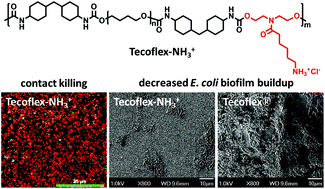Modification of a conventional polyurethane composition provides significant anti-biofilm activity against Escherichia coli†
Abstract
Catheter-associated urinary tract infections, caused by a build-up of biofilm on the catheter surface, are one of the most common nosocomial infections. For this work, we prepared a compositional variant of Tecoflex®, a commercial thermoplastic polyurethane (TPU), with peptide-like cationic pendant functional groups to study their effect on biofilm growth. Tecoflex® is used for fabrication of catheters and therefore a variant that shows decreased biofilm accumulation could have the potential to combat nosocomial infections. The cationic pendant groups were incorporated into the polyurethane composition similar to Tecoflex® by copolymerization of an amine functionalized N-substituted diol to give a cationic polyurethane (Tecoflex-NH3+). The antimicrobial properties of this cationic polyurethane were investigated using Escherichia coli, a Gram-negative bacterium and as confirmed by microscopy studies and bactericidal assays, the cationic polyurethane coating exhibited a contact-killing mechanism, and it significantly slowed down the build-up of biofilm compared to Tecoflex® coating. Moreover, the cationic polyurethane demonstrated minimal toxicity towards mammalian cells.



 Please wait while we load your content...
Please wait while we load your content...
